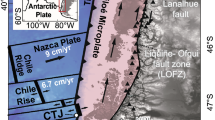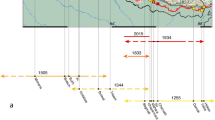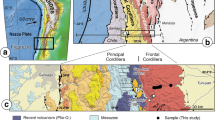Abstract
Tectonic models for the evolution of the Tibetan plateau interpret observed east–west thinning of the upper crust to be the result of either increased potential energy of elevated crust1 or geodynamic processes that may be unrelated to plateau formation2,3,4,5,6. A key piece of information needed to evaluate these models is the timing of deformation within the plateau. The onset of normal faulting has been estimated to have commenced in southern Tibet between about 14 Myr ago7 and about 8 Myr ago8 and, in central Tibet, about 4 Myr ago9. Here, however, we report a minimum age of approximately 13.5 Myr for the onset of graben formation in central Tibet, based on mineralization ages determined with Rb–Sr and 40Ar–39Ar data that post-date a major graben-bounding normal fault. These data, along with evidence for prolonged activity of normal faulting in this and other Tibetan grabens, support models that relate normal faulting to processes occurring beneath the plateau. Thinning of the upper crust is most plausibly the result of potential-energy increases resulting from spatially and temporally heterogeneous changes in thermal structure and density distribution within the crust and upper mantle beneath Tibet. This is supported by recent geophysical and geological data10,11,12,13,14,15,16,17, which indicate that spatial heterogeneity exists in both the Tibetan crust and lithospheric mantle.
This is a preview of subscription content, access via your institution
Access options
Subscribe to this journal
Receive 51 print issues and online access
$199.00 per year
only $3.90 per issue
Buy this article
- Purchase on Springer Link
- Instant access to full article PDF
Prices may be subject to local taxes which are calculated during checkout


Similar content being viewed by others
References
Molnar, P. & Tapponnier, P. Active tectonics of Tibet. J. Geophys. Res. 83, 5361–5375 (1978).
Yin, A. & Harrison, T. M. Geologic evolution of the Himalayan-Tibetan orogen. Annu. Rev. Earth Planet. Sci. Lett. 28, 211–280 (2000).
Armijo, R., Tapponnier, P. & Han, T. Late Cenozoic strike-slip faulting in southern Tibet. J. Geophys. Res. 94, 2787–2838 (1989).
Klootwijk, C. T., Conaghan, P. J. & Powell, C. M. The Himalayan arc: large-scale continental subduction, oroclinal bending and back-arc spreading. Earth Planet. Sci. Lett. 75, 167–183 (1985).
McCaffrey, R. & Nabelek, J. Role of oblique convergence in the active deformation of the Himalayas and southern Tibet plateau. Geology 26, 691–694 (1998).
Ratschbacher, L., Frisch, W., Lui, G. & Chen, C. Distributed deformation in southern and western Tibet during and after the India-Asia collision. J. Geophys. Res. 99, 19917–19945 (1994).
Coleman, M. & Hodges, K. Evidence for Tibetan plateau uplift before 14 Myr ago from a new minimum age for east-west extension. Nature 374, 49–52 (1995).
Harrison, T. M., Copeland, P., Kidd, W. S. F. & Lovera, O. M. Activation of the Nyainqentanghla Shear Zone: Implications for uplift of the southern Tibetan Plateau. Tectonics 14, 658–676 (1995).
Yin, A. et al. Evidence for significant Late Cenozoic E-W extension in North Tibet. Geology 27, 787–790 (1999).
Nelson, K. D. et al. An INDEPTH view of the structure of the lithosphere beneath southern Tibet. Science 274, 1684–1688 (1996).
Owens, T. J. & Zandt, G. Implications of crustal property variations for models of Tibetan plateau evolution. Nature 387, 37–43 (1997).
Kosarev, G. et al. Seismic evidence for a detached Indian lithospheric mantle beneath Tibet. Science 283, 1306–1309 (1999).
Hacker, B. R. et al. Hot and dry deep crustal xenoliths from Tibet. Science 287, 2463–2466 (2000).
Huang, W.-C. et al. Seismic polarization anisotropy beneath the central Tibetan Plateau. J. Geophys. Res. 105, 27979–27989 (2000).
Wei, W. et al. Detection of widespread fluids in the Tibetan crust by magnetotelluric studies. Science 292, 716–718 (2001).
Zhao, W. et al. Crustal structure of central Tibet as derived from project INDEPTH wide-angle seismic data. Geophys. J. Int. 145, 486–498 (2001).
Rodgers, A. J. & Schwartz, S. Y. Lithospheric structure of the Qiangtang Terrane, northern Tibetan Plateau, from complete regional waveform modeling: Evidence for partial melt. J. Geophys. Res. 103, 7137–7152 (1998).
England, P. & Searle, M. The Cretaceous-Tertiary deformation of the Lhasa Block and its implications for crustal thickening in Tibet. Tectonics 5, 1–14 (1986).
England, P. C. & Houseman, G. A. Extension during continental convergence, with application to the Tibetan plateau. J. Geophys. Res. 94, 17561–17579 (1989).
Harrison, T. M., Copeland, P., Kidd, W. S. F. & Yin, A. Raising Tibet. Science 255, 1663–1670 (1992).
Garzione, C. N., Dettman, D. L., Quade, J., DeCelles, P. G. & Butler, R. F. High times on the Tibetan Plateau: Paleoelevation of the Thakkola graben, Nepal. Geology 28, 339–342 (2000).
Williams, H., Turner, S., Kelley, S. & Harris, N. Age and composition of dikes in Southern Tibet: New constraints on the timing of east-west extension and its relationship to postcollisional volcanism. Geology 29, 339–342 (2001).
Molnar, P. & Lyon-Caen, H. Fault plane solutions of earthquakes and active tectonics of the northern and eastern parts of the Tibetan Plateau. Geophys. J. Int. 99, 123–153 (1989).
Hodges, K. V. et al. Simultaneous Miocene extension and shortening in the Himalayan orogen. Science 258, 1466–1470 (1992).
Hurtado, J. M., Hodges, K. V. & Whipple, K. X. Neotectonics of the Thakkola graben and implications for recent activity on the South Tibetan fault system in the central Nepal Himalaya. Bull. Geol. Soc. Am. 113, 222–240 (2001).
Zhang, Y., Vergely, P. & Mercier, J. L. Pliocene-Quaternary faulting pattern and left-slip propagation tectonics in North China. Episodes 22, 84–88 (1999).
Logatchev, N. A. & Zorin, Y. A. Evidence and causes of the two-stage development of the Baikal rift. Tectonophysics 143, 225–234 (1987).
Kroon, D., Steens, T. & Troelstra, S. R. Onset of monsoonal related upwelling in the western Arabian Sea as revealed by planktonic foraminifers. Proc. ODP Sci. Res. 116, 257–263 (1991).
Quade, J., Cerling, T. E. & Bowman, J. R. Development of Asian monsoon revealed by marked ecological shift during the latest Miocene in northern Pakistan. Nature 342, 163–166 (1989).
An, Z., Kutzbach, J. E., Prell, W. L. & Porter, S. C. Evolution of Asian monsoons and phased uplift of the Himalaya-Tibetan plateau since Late Miocene times. Nature 411, 62–66 (2001).
Acknowledgements
We thank E. Gnos, M. Strecker, W. Kidd, A. Yin and M. Edwards for discussions, and P. Molnar for comments and suggestions. This work was supported by Deutsche Forschungsgemeinschaft, the US NSF, and the Chinese Academy of Geological Sciences.
Author information
Authors and Affiliations
Corresponding author
Rights and permissions
About this article
Cite this article
Blisniuk, P., Hacker, B., Glodny, J. et al. Normal faulting in central Tibet since at least 13.5 Myr ago. Nature 412, 628–632 (2001). https://doi.org/10.1038/35088045
Received:
Accepted:
Issue Date:
DOI: https://doi.org/10.1038/35088045
This article is cited by
-
Genesis of Pb–Zn-Ag-Sb mineralization in the Tethys Himalaya, China: Early magmatic-hydrothermal Pb–Zn(-Ag) mineralization overprinted by Sb-rich fluids
Mineralium Deposita (2024)
-
Mississippi Valley-type Zn–Pb deposits in orogenic thrust belts: ore formation in response to synorogenic crustal transpression or extension
Mineralium Deposita (2023)
-
Episodic sandstone-type uranium mineralization in Asia during the Late Mesozoic-Cenozoic
Science China Earth Sciences (2023)
-
Surface wave imaging using deep reflection seismic data: a study on the Cuonadong dome
Earth, Planets and Space (2022)
-
Biotite composition as a tracer of fluid evolution and mineralization center: a case study at the Qulong porphyry Cu-Mo deposit, Tibet
Mineralium Deposita (2022)
Comments
By submitting a comment you agree to abide by our Terms and Community Guidelines. If you find something abusive or that does not comply with our terms or guidelines please flag it as inappropriate.



